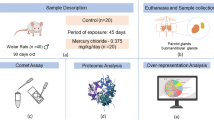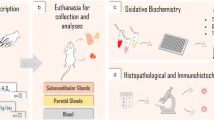Abstract
Environmental and occupational mercury exposure is considered a major public health issue. Despite being well known that MeHg exposure causes adverse effects in several physiologic functions, MeHg effects on salivary glands still not completely elucidated. Here, we investigated the cellular MeHg-induced damage in the three major salivary glands (parotid, submandibular, and sublingual) of adult rats after chronic, systemic and low doses of MeHg exposure. Rats were exposed by 0.04 mg/kg/day over 60 days. After that, animals were euthanized and all three glands were collected. We evaluated total Hg accumulation, metallothionein I/II (MT I/II), α-smooth muscle actin (α-SMA), and cytokeratin 18 (CK18) immune expression. Our results have showed that MeHg is able to disrupt gland tissue and to induce a protective mechanism by MT I/II expression. We also showed that cell MT production is not enough to protect gland tissue against cellular structural damage seen by reducing marking of cytoskeletal proteins as CK18 and α-SMA. Our data suggest that chronic MeHg exposure in low-daily doses is able to induce cellular damage in rat salivary glands.






Similar content being viewed by others
References
Clarkson TW, Magos L (2006) The toxicology of mercury and its chemical compounds. Crit Rev Toxicol 36(8):609–662. https://doi.org/10.1080/10408440600845619
Li WC, Tse HF (2015) Health risk and significance of mercury in the environment. Environ Sci Pollut Res Int 22(1):192–201. https://doi.org/10.1007/s11356-014-3544-x
Bernhoft RA (2012) Mercury toxicity and treatment: a review of the literature. J Environ Public Health 2012:460508. https://doi.org/10.1155/2012/460508
Kim SJ, Lee HK, Badejo AC, Lee WC, Moon HB (2016) Species-specific accumulation of methyl and total mercury in sharks from offshore and coastal waters of Korea. Mar Pollut Bull 102(1):210–215. https://doi.org/10.1016/j.marpolbul.2015.11.038
Li SJ, Zhang SH, Chen HP, Zeng CH, Zheng CX, Li LS, Liu ZH (2010) Mercury-induced membranous nephropathy: clinical and pathological features. Clin J Am Soc Nephrol: CJASN 5(3):439–444. https://doi.org/10.2215/CJN.07571009
Tan SW, Meiller JC, Mahaffey KR (2009) The endocrine effects of mercury in humans and wildlife. Crit Rev Toxicol 39(3):228–269. https://doi.org/10.1080/10408440802233259
Holmes P, James KA, Levy LS (2009) Is low-level environmental mercury exposure of concern to human health? Sci Total Environ 408(2):171–182. https://doi.org/10.1016/j.scitotenv.2009.09.043
Bittencourt LO, Puty B, Charone S, WAB A, Farias-Junior PM, MCF S, Crespo-Lopez ME, AdL L, MAR B, Lima RR (2017) Oxidative Biochemistry Disbalance and Changes on Proteomic Profile in Salivary Glands of Rats Induced by Chronic Exposure to Methylmercury. Oxidative Med Cell Longev 2017:15. https://doi.org/10.1155/2017/5653291
Islas-Granillo H, Borges-Yanez A, Fernandez-Barrera MA, Avila-Burgos L, Patino-Marin N, Marquez-Corona ML, Mendoza-Rodriguez M, Medina-Solis CE (2017) Relationship of hyposalivation and xerostomia in Mexican elderly with socioeconomic, sociodemographic and dental factors. Sci Rep 7:40686. https://doi.org/10.1038/srep40686
Mese H, Matsuo R (2007) Salivary secretion, taste and hyposalivation. J Oral Rehabil 34(10):711–723. https://doi.org/10.1111/j.1365-2842.2007.01794.x
Kong HK, Wong MH, Chan HM, Lo SC (2013) Chronic exposure of adult rats to low doses of methylmercury induced a state of metabolic deficit in the somatosensory cortex. J Proteome Res 12(11):5233–5245. https://doi.org/10.1021/pr400356v
Akagi H, Nishimura H (1991) Speciation of Mercury in the Environment. In: Suzuki T, Imura N, Clarkson TW (eds) Advances in Mercury Toxicology. Springer US, Boston, pp 53–76. https://doi.org/10.1007/978-1-4757-9071-9_3
Teixeira FB, Fernandes RM, Farias-Junior PM, Costa NM, Fernandes LM, Santana LN, Silva-Junior AF, Silva MC, Maia CS, Lima RR (2014) Evaluation of the effects of chronic intoxication with inorganic mercury on memory and motor control in rats. Int J Environ Res Public Health 11(9):9171–9185. https://doi.org/10.3390/ijerph110909171
Bhandari S, Melchiorre C, Dostie K, Laukens D, Devisscher L, Louwrier A, Thees A, Lynes MA (2017) Detection and Manipulation of the Stress Response Protein Metallothionein. Curr Protoc Toxicol 71:17.19.11–17.19.28. https://doi.org/10.1002/cptx.17
Chu PG, Weiss LM (2002) Keratin expression in human tissues and neoplasms. Histopathology 40(5):403–439
Ogawa Y (2003) Immunocytochemistry of myoepithelial cells in the salivary glands. Prog Histochem Cytochem 38(4):343–426
da Costa NM, Correa RS, Junior IS, Figueiredo AJ, Vilhena KF, Farias-Junior PM, Teixeira FB, Ferreira NM, Pereira-Junior JB, Dantas K, da Silva MC, Silva-Junior AF, Alves-Junior Sde M, Pinheiro Jde J, Lima RR (2014) Physical, chemical, and immunohistochemical investigation of the damage to salivary glands in a model of intoxication with aluminium citrate. Int J Environ Res Public Health 11(12):12429–12440. https://doi.org/10.3390/ijerph111212429
Silva AF, Aguiar MS, Carvalho OS, Santana Lde N, Franco EC, Lima RR, Siqueira NV, Feio RA, Faro LR, Gomes-Leal W (2013) Hippocampal neuronal loss, decreased GFAP immunoreactivity and cognitive impairment following experimental intoxication of rats with aluminum citrate. Brain Res 1491:23–33. https://doi.org/10.1016/j.brainres.2012.10.063
Clarkson TW (1972) The biological properties and distribution of mercury. Biochem J 130(2):61P–63P
Liu J, Lu YF, Li WK, Zhou ZP, Li YY, Yang X, Li C, Du YZ, Wei LX (2016) Mercury sulfides are much less nephrotoxic than mercury chloride and methylmercury in mice. Toxicol Lett 262:153–160. https://doi.org/10.1016/j.toxlet.2016.10.003
Clarkson TW (2002) The three modern faces of mercury. Environ Health Perspect 110(Suppl 1):11–23
Shi JZ, Kang F, Wu Q, Lu YF, Liu J, Kang YJ (2011) Nephrotoxicity of mercuric chloride, methylmercury and cinnabar-containing Zhu-Sha-An-Shen-Wan in rats. Toxicol Lett 200(3):194–200. https://doi.org/10.1016/j.toxlet.2010.11.015
Schmid K, Sassen A, Staudenmaier R, Kroemer S, Reichl FX, Harreus U, Hagen R, Kleinsasser N (2007) Mercuric dichloride induces DNA damage in human salivary gland tissue cells and lymphocytes. Arch Toxicol 81(11):759–767. https://doi.org/10.1007/s00204-007-0208-3
Ikeda R (2011) Morphological and Histochemical Changes in the Parenchyma of the Rat Parotid and Sublingual Glands with Growth and Aging. J Oral Biosci 53(4):289–297. https://doi.org/10.1016/S1349-0079(11)80021-6
Fedirko NV, Kruglikov IA, Kopach OV, Vats JA, Kostyuk PG, Voitenko NV (2006) Changes in functioning of rat submandibular salivary gland under streptozotocin-induced diabetes are associated with alterations of Ca2+ signaling and Ca2+ transporting pumps. Biochim Biophys Acta 1762(3):294–303. https://doi.org/10.1016/j.bbadis.2005.12.002
Yasutake A, Nakamura M (2011) Induction by mercury compounds of metallothioneins in mouse tissues: inorganic mercury accumulation is not a dominant factor for metallothionein induction in the liver. J Toxicol Sci 36(3):365–372
Dabrio M, Rodriguez AR, Bordin G, Bebianno MJ, De Ley M, Sestakova I, Vasak M, Nordberg M (2002) Recent developments in quantification methods for metallothionein. J Inorg Biochem 88(2):123–134
Chan J, Huang Z, Merrifield ME, Salgado MT, Stillman MJ (2002) Studies of metal binding reactions in metallothioneins by spectroscopic, molecular biology, and molecular modeling techniques. Coord Chem Rev 233(Supplement C):319–339. https://doi.org/10.1016/S0010-8545(02)00176-5
Thirumoorthy N, Shyam Sunder A, Manisenthil Kumar K, Senthil Kumar M, Ganesh G, Chatterjee M (2011) A review of metallothionein isoforms and their role in pathophysiology. World J Surg Oncol 9:54. https://doi.org/10.1186/1477-7819-9-54
Higashimoto M, Isoyama N, Ishibashi S, Inoue M, Takiguchi M, Suzuki S, Ohnishi Y, Sato M (2009) Tissue-dependent preventive effect of metallothionein against DNA damage in dyslipidemic mice under repeated stresses of fasting or restraint. Life Sci 84(17-18):569–575. https://doi.org/10.1016/j.lfs.2009.01.022
Babula P, Masarik M, Adam V, Eckschlager T, Stiborova M, Trnkova L, Skutkova H, Provaznik I, Hubalek J, Kizek R (2012) Mammalian metallothioneins: properties and functions. Metallomics: Integr Biometal Sci 4(8):739–750. https://doi.org/10.1039/c2mt20081c
Hwang TL, Chen HY, Changchien TT, Wang CC, Wu CM (2013) The cytotoxicity of mercury chloride to the keratinocytes is associated with metallothionein expression. Biomed Rep 1(3):379–382. https://doi.org/10.3892/br.2013.65
Schurz F, Sabater-Vilar M, Fink-Gremmels J (2000) Mutagenicity of mercury chloride and mechanisms of cellular defence: the role of metal-binding proteins. Mutagenesis 15(6):525–530
Thier R, Bonacker D, Stoiber T, Bohm KJ, Wang M, Unger E, Bolt HM, Degen G (2003) Interaction of metal salts with cytoskeletal motor protein systems. Toxicol Lett 140-141:75–81
Nersesyan A, Kundi M, Waldherr M, Setayesh T, Misik M, Wultsch G, Filipic M, Mazzaron Barcelos GR, Knasmueller S (2016) Results of micronucleus assays with individuals who are occupationally and environmentally exposed to mercury, lead and cadmium. Mutat Res 770(Pt A):119–139. https://doi.org/10.1016/j.mrrev.2016.04.002
Crespo-Lopez ME, Macedo GL, Pereira SI, Arrifano GP, Picanco-Diniz DL, do Nascimento JL, Herculano AM (2009) Mercury and human genotoxicity: critical considerations and possible molecular mechanisms. Pharmacol Res 60(4):212–220. https://doi.org/10.1016/j.phrs.2009.02.011
Coulombe PA, Omary MB (2002) ‘Hard’ and ‘soft’ principles defining the structure, function and regulation of keratin intermediate filaments. Curr Opin Cell Biol 14(1):110–122
Ma L, Xu J, Coulombe PA, Wirtz D (1999) Keratin Filament Suspensions Show Unique Micromechanical Properties. J Biol Chem 274(27):19145–19151. https://doi.org/10.1074/jbc.274.27.19145
Oriolo AS, Wald FA, Ramsauer VP, Salas PJ (2007) Intermediate filaments: a role in epithelial polarity. Exp Cell Res 313(10):2255–2264. https://doi.org/10.1016/j.yexcr.2007.02.030
Moll R, Divo M, Langbein L (2008) The human keratins: biology and pathology. Histochem Cell Biol 129(6):705–733. https://doi.org/10.1007/s00418-008-0435-6
Balachander N, Masthan KMK, , Anbazhagan V (2015) Myoepithelial cells in pathology. J Pharm Bioallied Sci 7 (Suppl 1):S190-S193. https://doi.org/10.4103/0975-7406.155898
Saleh J, Figueiredo MA, Cherubini K, Salum FG (2015) Salivary hypofunction: an update on aetiology, diagnosis and therapeutics. Arch Oral Biol 60(2):242–255. https://doi.org/10.1016/j.archoralbio.2014.10.004
Funding
This work was supported by the Brazilian National Council for Scientific and Technological Development (CNPq), Fundação de Amparo a Pesquisa do Estado do Pará (FAPESPA), and Pró-Reitoria de Pesquisa e Pós-Graduação da UFPA (PROPESP, UFPA, Brazil). Leidiane A. O. Lima is a scholar supported by UFPA. Rafael R. Lima is an investigator from CNPq (Edital MCTI/CNPQ/Universal 14/2014).
Author information
Authors and Affiliations
Corresponding author
Ethics declarations
All procedures were previously approved by Ethics committee on animal experimentation by Federal University of Para (BIO 225-14 - CEPAE-UFPA) following the guidelines suggested by NIH Guide to Care and Use of Laboratory Animals.
Rights and permissions
About this article
Cite this article
Lima, L.A.d.O., Bittencourt, L.O., Puty, B. et al. Methylmercury Intoxication Promotes Metallothionein Response and Cell Damage in Salivary Glands of Rats. Biol Trace Elem Res 185, 135–142 (2018). https://doi.org/10.1007/s12011-017-1230-9
Received:
Accepted:
Published:
Issue Date:
DOI: https://doi.org/10.1007/s12011-017-1230-9




